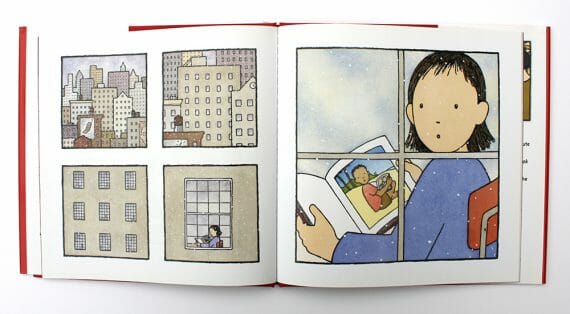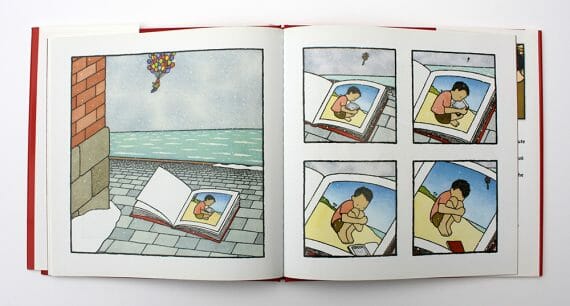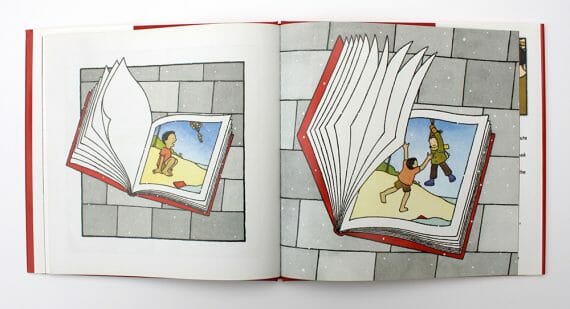The Red Book
Barbara Lehman
Imagine finding a red book peeping out of a pile of snow, lifting it up and opening it… only to discover a little boy on a sunny beach staring back at you through the pages of an identical red book.
This is the premise behind Barbara Lehman’s wordless picturebook The Red Book and it’s a thought experiment that can easily tie you in knots as you try to work out who is looking at whom. But in fact it’s simply a visual realisation of what we all do when we ‘lose’ ourselves in a book – when the characters in the story reveal themselves to be so vividly drawn that it’s as if we know them as friends and neighbours in real life.

In this title, which is itself a red book, Lehman literally draws her characters, eschewing words and using only watercolour, gouache and ink to depict her scenes. Her clear yet detailed illustrations create an imaginary universe where, according to the blurb, a small red book can cross ‘oceans and continents to deliver one girl into a new world of possibility, where a friend she’s never met is waiting’. In our current globally connected society, immersed as it is in social media and Google Maps, that idea of yet undiscovered friends on the other side of the planet is a distinctly appealing one.
Indeed the motif of a map features significantly in The Red Book. The first image the book reveals to the girl is of a gridded map, and subsequently the focus zooms right through the map’s grid to an isolated, unnamed island. Later, another map, one of the entire world, can be seen hanging on the girl’s school wall. And on her website, Lehman says it was maps that inspired her to create this book: ‘I used to stare at the maps in school and wish I could look right into a map itself and be able to see the actual places they represented and the people who lived there.’

Throughout, Lehman uses strong horizontal and vertical lines as frames to link the two viewpoints of the girl and the boy, mirroring the grid of the map with the angular outlines of high-rise apartment block windows. There are other opposing ‘reflections’ here too, including contrasts between busy cityscape and isolated island, loneliness and friendship, and even the chilliness of snow and the warmth of the sun.
In The Red Book, the magical element that provides a physical link between the girl and the boy is a bunch of colourful helium balloons. The girl uses them to fly across the world to the boy’s remote beach. On the flight, the girl accidentally drops her red book. It lands on a pavement and – once the reader has had the satisfaction of witnessing the two children’s meeting through its pages – the cover blows shut. Later a young man, seeing a stray book on the sidewalk, picks it up and cycles off with it.

So the tale within The Red Book has the potential to reinvent itself, with new people and fresh locations. In fact the stories could go on and on and on, much like a hall of mirrors. That’s quite a deep philosophical idea for a young children’s picturebook!
The Red Book won Lehman, a Chicago-born artist, a Caldecott Honor award in 2005, as well as a number of other awards. She has gone on to create several other wordless books including Rainstorm (2007), Trainstop (2008) and The Secret Box (2011).